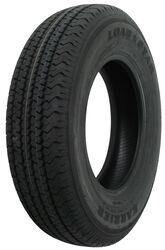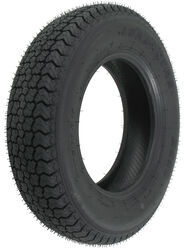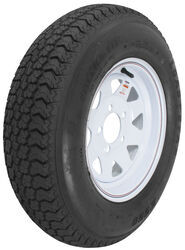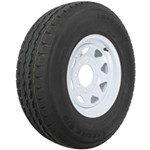
Comparing Tire Sizes ST185/80D13 and ST175/80R13 and Bias Ply/Radial Tire Construction
Question:
I have a 1999 Coleman Mesa pop up trailer and I need to replace the tires. I brought the tires, which are ST185/80D13 to a local tire shop and asked to have them replaced I know very little about tires - other than I dont want to have a blow out when I pull the camper 3,000 miles this summer. They put new tires on, but I noticed they are ST175/80R13. I called and asked why they dont match the old tire I brought in and was told that the old tire is antiquated technology and that the new tire is far superior. Im curious what you think?
asked by: Steve
Expert Reply:
We offer both of the trailer tire sizes you mentioned, ST175/80R13 and ST185/80D13. In terms of size they are very close to one another; the ST175/80R13 size measures 24.1-inches in diameter and 6.9-inches wide while the ST185/80D13 size measures 24.4-inches in diameter and 7.2-inches wide. Both tire sizes fit on the same wheel sizes, 13-inchers that are 4-1/2, 5 or 5-1/2-inches wide. In most trailer applications these two tire sizes are going to be interchangeable.
The "antiquated technology" mentioned to you refers to the tire type. The letter D in a tire like Loadstar ST175/80D13 # AM1ST77 denotes that it is a bias ply type tire; the letter R in a tire such as # AM10210 denotes that it is a radial tire. The difference is simply how the belts are arranged inside the tire. Bias ply tires have stiffer sidewalls that make then better suited to rougher off-road driving while radial tires have sidewalls that can flex more which gives better traction and cornering performance on the highway. Both tire types are still made to handle these different needs and it may be unfair to call one antiquated.
What I suggest you do is confirm your pop-up's GVWR, the most it can weigh when loaded. On a single axle Coleman Mesa pop-up each tire needs to be able to handle half that weight. Of course you will ideally have some extra capacity for safety margin. If you locate the weight Load Range rating on your new tires you can refer to the linked article to determine how much weight each can handle.
The best way to avoid tire failures is to always inflate to the maximum psi pressure shown on the tire sidewall, and to operate the tires within their weight capacity and within their speed rating.

Products Referenced in This Question
Karrier ST175/80R13 Radial Trailer Tire - Load Range D
- Trailer Tires and Wheels
- Tire Only
- Radial Tire
- Load Range D
- 175/80-13
- 13 Inch
- M - 81 mph
- Kenda
more information >
Loadstar ST175/80D13 Bias Trailer Tire - Load Range D
- Trailer Tires and Wheels
- Tire Only
- Bias Ply Tire
- Load Range D
- 175/80-13
- 13 Inch
- M - 81 mph
- Kenda
more information >
Product Page this Question was Asked From
Loadstar ST185/80D13 Bias Trailer Tire with 13" White Wheel - 5 on 4-1/2 - Load Range D
- Trailer Tires and Wheels
- Tire with Wheel
- Bias Ply Tire
- Load Range D
- 185/80-13
- 13 Inch
- M - 81 mph
- 5 on 4-1/2 Inch
- Steel Wheels - Powder Coat
- Kenda
more information >
Featured Help Information
Miscellaneous Media

Continue Researching
- Shop: Karrier ST175/80R13 Radial Trailer Tire with 13" Galvanized Wheel - 5 on 4-1/2 - Load Range D
- Shop: Karrier ST185/80R13 Radial Trailer Tire with 13" Aluminum Wheel - 5 on 4-1/2 - Load Range D
- Shop: Loadstar ST185/80D13 Bias Trailer Tire with 13" Galvanized Wheel - 5 on 4-1/2 - Load Range D
- Video: Review of Kenda Trailer Tires and Wheels - Karrier ST185/80R13 LR D Radial Aluminum Wheel - KE33JR
- Shop: Loadstar ST175/80D13 Bias Trailer Tire with 13" Galvanized Wheel - 5 on 4-1/2 - Load Range D
- Shop: Loadstar ST185/80D13 Bias Trailer Tire w/13" White Modular Wheel - 5 on 4-1/2 - Load Range D
- Shop: Kenda Karrier ST175/80R13 Radial Trailer Tire with 13" Black Mod Wheel - 5 on 4-1/2 - LR D
- Shop: Loadstar ST185/80D13 Bias Trailer Tire with 13" White Wheel - 5 on 4-1/2 - Load Range D
- Video: Review of Kenda Trailer Tires and Wheels - Karrier ST175/80R13 LR C Radial Aluminum Wheel - KE53JR
- Q&A: Is There A Picture Of This KE33JR So I Can See Exactly What It Looks Like
- Search Results: st17580r13
- Search Results: st185 80 r13
- Video: Kenda Tires and Wheels - Tire with Wheel - AM31242 Review
- Search Results: tires
- Q&A: How to Charge a Trailer Battery Through a 7-Way Connector
- Video: Review of Kenda Trailer Tires and Wheels - Tire with Wheel - AM31991
- Video: Kenda Tires and Wheels - Tire with Wheel - AM32001HWTB Review
- Q&A: Will a 175/80-13 Trailer Tire Fit the Same Wheel as a 185/80-13 Trailer Tire
- Video: Kenda Tires and Wheels - Tire with Wheel - AM31994 Review
- Search Results: spare tire mount
- Article: Trailer Tire Sizing
- Q&A: Can a 13 inch Trailer Wheel be Replaced with a 14 inch Wheel
- Q&A: ST175/80R13 Radial Trailer Tire Load Range D Availability With an Aluminum Wheel 5 On 4-1/2
- Video: Kenda Tires and Wheels - Tire with Wheel - AM3S331 Review
- Q&A: Lug Nut Torque for a Trailer Wheel
- Q&A: Comparing a 185/80-13 Tire to the 175/80-13 Size on Americana Trailer Tire AM1ST77
- Article: Trailer Wiring Diagrams
- Search Results: wheel cover
- Search Results: tire cover
- Shop: Wheel Cover



























